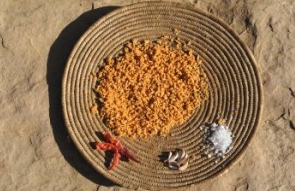 Shallots (Allium cepa var. aggregatum), a relative of the onion, with a unique sweet and rich flavor, have long been appreciated for their use as a staple ingredient for many popular dishes. The nutritional and savory part of this vegetable is the bulb which grows underground and produces leaves, flowers, and fruits above ground.
Shallots (Allium cepa var. aggregatum), a relative of the onion, with a unique sweet and rich flavor, have long been appreciated for their use as a staple ingredient for many popular dishes. The nutritional and savory part of this vegetable is the bulb which grows underground and produces leaves, flowers, and fruits above ground.
In Mali, shallots have proven to be an economically beneficial cash crop, providing women in small villages a successful way to support their families. The dogon shallot is found in environmentally stressed land in the Bandiagarà escarpment between Mopti and Timbuktu. This area is home to the Dogon people, an ethnic group who have been intensely studied by anthropologists due to their unique culture. An increase in tourism in the area to visit the Dogon village and UNESCO World Heritage Site is creating a greater market for the dogon shallot.
The Dogon shallots are low in saturated fat, cholesterol, and sodium and high in vitamin A, vitamin B6, manganese, vitamin C, folate, and potassium. The bulbs are used for food, spice and seasoning and can be used fresh, pickled, cooked, or fried. The vitamins and minerals present in the bulb have also prompted its use in medicines. In addition to being exported as a cash crop, the Dogon people also use the shallot for a variety of purposes. Dogon Somè is a condiment used regularly in the Dogon diet and consists of the shallot and other local ingredients such as, gangadjou, oroupounnà, and pourkamà. The women transform the leaves, flowers, and fruit of each plant into usable ingredients for dogon somè.
The economic success of the dogon shallot can be attributed, partly, to the recent involvement ofUSAID/Mali’s Integrated Initiatives for Economic Growth program (IICEM) with funds from the Global Food Security Response (GFSR). Prior to USAIDs involvement, the Dogons were previously unaware of how to properly cultivate the shallot. As a result, they would spoil or get moldy easily, making them hard to sell. USAID was able to provide farmers with appropriate fertilizer, application techniques, and access to technology. Technologies, such as new mechanized grinders, are increasing production from 50 kilograms a day to 1 ton per hour. Additionally, improved storage facilities have allowed better crop preservation and give the farmers the chance to wait for higher prices at market.
Greater efficiency in shallot harvesting has been substantial in the lives of the people who live in the villages, especially the women. After processing the product can be sold either dried with the leaves removed or in a fermented ball. The traditional method of drying involves the women grinding the shallots in a stone mortar, shaping the paste into pellets, and drying them in the sun. Some NGOs, including Slow Food International, have also promoted new drying methods, cutting the shallots into thin slices and drying them on lattices in the sun, that are less time consuming.
In 2009 USAID sent women from the village to a conference in Burkina Faso in order to share their experience and their shallots. The attendees at the conference enjoyed the shallots so much that the women won a first place prize of $1700 and one woman received an order for 25 tons of her delicious shallot.
By Evelyn Drawec

Danielle Nierenberg, an expert on livestock and sustainability, currently serves as Project Director of State of World 2011 for the Worldwatch Institute, a Washington, DC-based environmental think tank. Her knowledge of factory farming and its global spread and sustainable agriculture has been cited widely in the New York Times Magazine, the International Herald Tribune, the Washington Post, and
other publications.
Danielle worked for two years as a Peace Corps volunteer in the Dominican Republic. She is currently traveling across Africa looking at innovations that are working to alleviate hunger and poverty and blogging everyday at Worldwatch Institute’s Nourishing the Planet. She has a regular column with the Mail & Guardian, the Kansas City Star, and the Huffington Post and her writing was been featured in newspapers across Africa including the Cape Town Argus, the Zambia Daily Mail, Coast Week (Kenya), and other African publications. She holds an M.S. in agriculture, food, and environment from Tufts University and a B.A. in environmental policy from Monmouth College.








